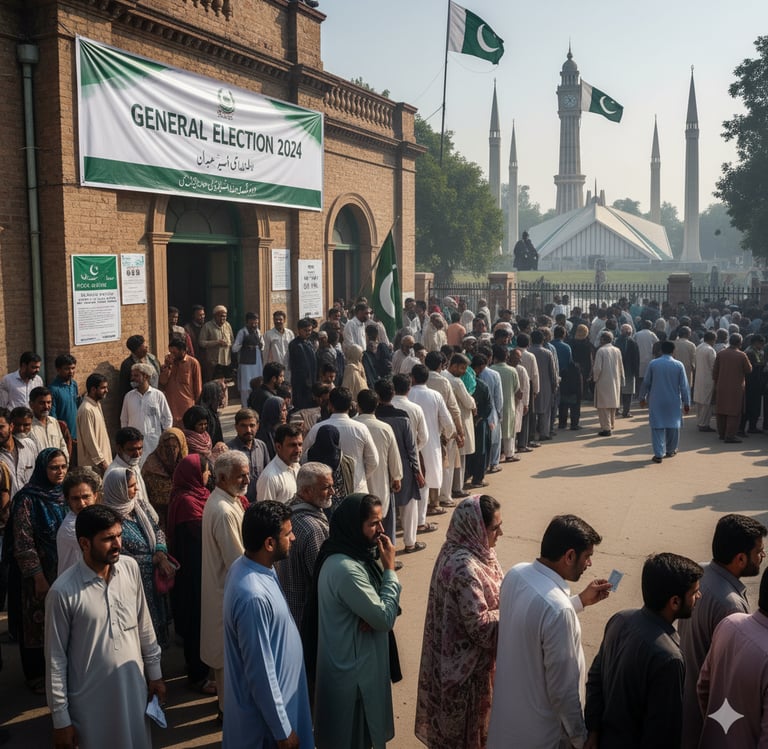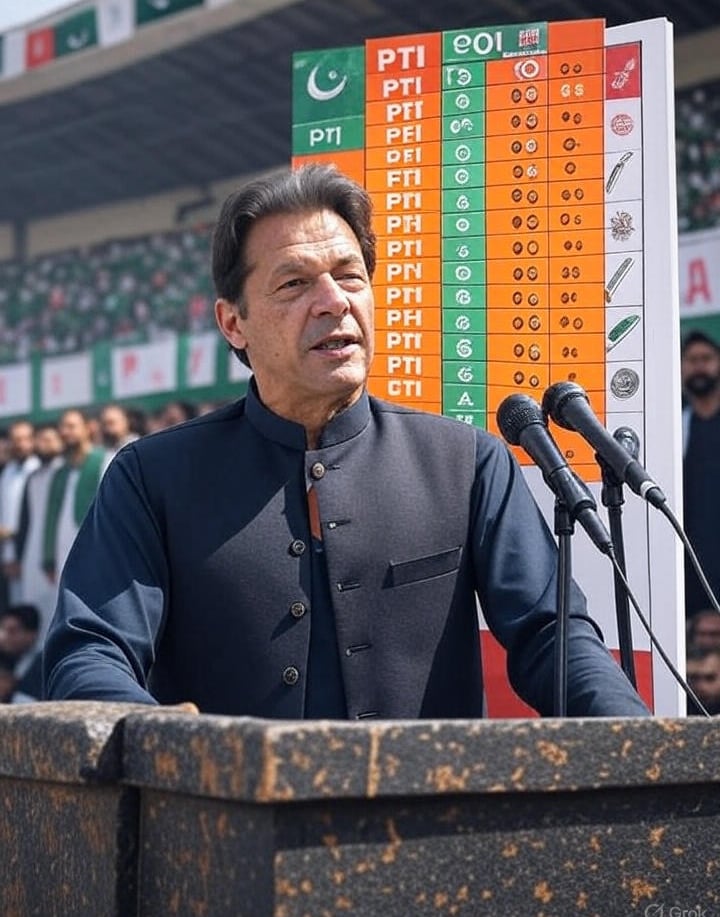Top 10 Most Popular Political Parties in Pakistan
Discover the Top 10 most popular political parties in Pakistan 2024 General Election based on voter support, vote share, and seats won. PTI, PML-N, PPP, and more – see who leads Pakistan’s political landscape.
Admin
9/17/20254 منٹ پڑھیں


Top 10 Most Popular Political Parties in Pakistan: 2024 General Election Results
The 2024 Pakistan general election, held on February 8, 2024, was a pivotal moment for the country’s political landscape. With 128 million registered voters and 5,121 candidates vying for 266 National Assembly seats, the election showcased the strength of Pakistan’s democracy despite allegations of rigging and military interference. In this blog, we explore the top 10 most popular political parties in Pakistan based on voter support in the 2024 election, focusing on seat wins, vote share, and regional influence. Whether you’re searching for insights into Pakistan election results 2024, popular political parties in Pakistan, or voter trends in Pakistan, this guide has you covered.
1. Pakistan Tehreek-e-Insaf (PTI)
Seats Won: 93-101 (as independents)
Ideology: Centrist-right, anti-corruption, Islamic democracy
Key Leader: Imran Khan (imprisoned)
Why Popular?: Despite being barred from using its iconic cricket bat symbol, PTI dominated the 2024 general election, with its backed independents securing the most seats (93-101 out of 266). PTI’s appeal lies in its anti-establishment stance, youth-driven campaigns, and Imran Khan’s enduring popularity. Its strongholds in Khyber Pakhtunkhwa and Punjab make it the most popular political party in Pakistan. PTI’s use of social media and AI-based campaigning overcame significant obstacles, including media blackouts and candidate harassment.
2. Pakistan Muslim League-Nawaz (PML-N)
Seats Won: 75
Ideology: Center-right, pro-business, conservative
Key Leaders: Nawaz Sharif, Shehbaz Sharif
Why Popular?: PML-N emerged as the largest parliamentary party post-election, forming a coalition government under Shehbaz Sharif. Its stronghold in Punjab, Pakistan’s most populous province, and pro-military alignment bolstered its support. Despite trailing PTI in direct seats, PML-N gained additional reserved seats for women and minorities, enhancing its influence. Keywords: PML-N, Nawaz Sharif, Shehbaz Sharif, Punjab politics, Pakistan coalition government.
3. Pakistan Peoples Party Parliamentarians (PPPP)
Seats Won: 54
Ideology: Center-left, socialist, populist
Key Leaders: Bilawal Bhutto Zardari, Asif Ali Zardari
Why Popular?: The PPP remains a major force, particularly in rural Sindh. Led by the young Bilawal Bhutto Zardari, the party leverages its historical legacy under Zulfikar Ali Bhutto and Benazir Bhutto. Its coalition with PML-N post-election solidified its role in national politics, though its national appeal has waned. Keywords: PPP Pakistan, Bilawal Bhutto, Sindh politics, Pakistan election results.
4. Muttahida Qaumi Movement Pakistan (MQM-P)
Seats Won: 17
Ideology: Centrist, Muhajir interests
Key Leader: Khalid Maqbool Siddiqui
Why Popular?: MQM-P holds significant sway in urban Sindh, especially Karachi, representing Muhajir communities. Despite internal factionalism, it secured 17 seats and joined the PML-N-led coalition, amplifying its influence. Its focus on urban issues resonates with voters in Pakistan’s largest city. Keywords: MQM Pakistan, Karachi politics, Muhajir vote, Pakistan political parties.
5. Jamiat Ulema-e-Islam Fazl (JUI-F)
Seats Won: 11
Ideology: Right-wing, Islamic conservatism
Key Leader: Fazlur Rehman
Why Popular?: JUI-F draws support from religious seminaries, particularly in Khyber Pakhtunkhwa and Balochistan. Although it lost ground to PTI in its traditional strongholds, its conservative base ensures steady voter support. Keywords: JUI-F, Fazlur Rehman, religious parties Pakistan, Khyber Pakhtunkhwa politics.
6. Balochistan Awami Party (BAP)
Seats Won: 5
Ideology: Centrist, Baloch interests
Key Leader: Khalid Hussain Magsi
Why Popular?: BAP is a key player in Balochistan, often aligning with the military establishment. It contested 10 National Assembly seats and secured 5, making it a potential coalition partner. Its regional focus ensures consistent support among Baloch voters. Keywords: BAP Pakistan, Balochistan politics, coalition parties Pakistan.
7. Pakistan Muslim League (PML)
Seats Won: 3
Ideology: Center-right, conservative
Key Leader: Chaudhry Shujaat Hussain
Why Popular?: Known as PML-Q, this faction of the Pakistan Muslim League has a smaller but loyal base in Punjab. Its alignment with PTI in 2023 boosted its relevance, though its influence is limited compared to PML-N. Keywords: PML-Q, Chaudhry Shujaat, Punjab political parties.
8. Istehkam-e-Pakistan Party (IPP)
Seats Won: 3
Ideology: Centrist, pro-establishment
Key Leader: Jahangir Tareen
Why Popular?: A newer party formed by former PTI members, IPP gained traction in Punjab with establishment backing. It won 3 seats and joined the ruling coalition, appealing to voters seeking stability. Keywords: IPP Pakistan, Jahangir Tareen, pro-establishment parties.
9. Pakistan Muslim League-Zia (PML-Z)
Seats Won: 1
Ideology: Right-wing, conservative
Key Leader: Ijazul Haq
Why Popular?: PML-Z, led by the son of former dictator Ziaul Haq, has niche support among conservative voters. Its single seat reflects limited but targeted appeal. Keywords: PML-Z, Ijazul Haq, conservative politics Pakistan.
10. National Party (NP)
Seats Won: 1
Ideology: Left-wing, Baloch nationalism
Key Leader: Abdul Malik Baloch
Why Popular?: The National Party focuses on Balochistan’s regional issues, advocating for Baloch rights. Its single seat underscores its role as a minor but relevant player in coalition dynamics. Keywords: National Party Pakistan, Baloch nationalism, regional politics.
Why These Parties Matter in Pakistan’s Political Landscape
The 2024 Pakistan election highlighted a polarized electorate, with PTI leading in voter enthusiasm despite significant barriers. PML-N and PPP, traditional powerhouses, rely on dynastic politics and regional strongholds, while smaller parties like MQM-P, JUI-F, and BAP play critical roles in coalition-building. The election’s controversies, including allegations of rigging and military influence, underscore the challenges facing Pakistan’s democracy. For those searching for Pakistan political parties 2024, voter support trends, or election analysis, these results reflect a dynamic and contested political arena.
Conclusion
The top political parties in Pakistan for 2024 showcase a mix of anti-establishment fervor (PTI), dynastic legacies (PML-N, PPP), and regional influence (MQM-P, BAP, NP). PTI’s dominance in voter support, despite its candidates running as independents, signals a shift toward youth-driven, anti-corruption politics. For more insights into Pakistan election trends, political party rankings, or 2024 voter preferences, stay tuned for updates on Pakistan’s evolving political scene.
Sources: Election Commission of Pakistan, Statista, Al Jazeera, House of Commons Library
Note: Most Popular Political Party in Pakistan on September 18, 2025
As of today, September 18, 2025, the Pakistan Tehreek-e-Insaf (PTI) remains the most popular political party in Pakistan, based on its performance in the February 8, 2024, general election and ongoing public sentiment. PTI-backed independent candidates secured approximately 93-101 seats out of 266 in the National Assembly, outperforming all other parties despite being stripped of its official symbol and facing significant state-led restrictions.
Why PTI is Most Popular:
1. Grassroots Support: PTI’s anti-establishment message resonates strongly with Pakistan’s youth and urban middle class, particularly in Khyber Pakhtunkhwa and Punjab. Its focus on anti-corruption and governance reform aligns with public frustration over economic challenges and inflation.
2. Imran Khan’s Charisma: Despite his imprisonment since 2023, Imran Khan’s personal approval rating remains high (50-60% in polls), bolstered by sympathy for his legal battles and perceived victimization by the military and rival parties.
3. Digital Mobilization: PTI’s savvy use of social media, including platforms like X, has kept its base energized, with supporters framing the 2024 election as a defiance of establishment rigging.
4. Electoral Performance: Winning the most seats as independents, despite obstacles, reflects unmatched voter enthusiasm, especially in urban centers and among younger demographics.
While the Pakistan Muslim League-Nawaz (PML-N) leads the coalition government, its popularity trails PTI due to perceptions of dynastic politics and military backing. PTI’s ability to maintain momentum amid adversity solidifies its position as Pakistan’s most popular party today.

